Evaluating the Effectiveness of Transparent Communication in Learning
VerifiedAdded on 2021/04/24
|33
|7119
|205
Report
AI Summary
This report examines the effectiveness of transparent communication in the education system of the Maldives. The research explores the perception of verbal and non-verbal communication between teachers and students to improve the learning process. The study highlights the importance of one-to-one communication, understanding teaching techniques, and the role of skill and motivation. It aligns communication theories to understand the process and includes a primary research method to gather teachers' perspectives, with a focus on verbal communication and the behavioral framework of learning. The report emphasizes the need for efficient teacher recruitment to enhance literacy rates. The research covers the education system's background, objectives, research rationale, limitations, and hypothesis. It delves into communication theories, theoretical perspectives, academic motivation, and the Maldives' educational environment. The methodology includes research philosophy, approach, design, data collection methods, and analysis, along with findings and recommendations for future research. The report offers a comprehensive analysis of the challenges and opportunities for improving communication and education in the Maldives.

Running head: EFFECTIVENESS OF TRANSPARENT COMMUNICATION IN LEARNING
EFFECTIVENESS OF TRANSPARENT COMMUNICATION IN LEARNING
Name of the Student
Name of the University
Author Note
EFFECTIVENESS OF TRANSPARENT COMMUNICATION IN LEARNING
Name of the Student
Name of the University
Author Note
Paraphrase This Document
Need a fresh take? Get an instant paraphrase of this document with our AI Paraphraser

1EFFECTIVENESS OF TRANSPARENT COMMUNICATION IN LEARNING
Abstract
The research paper has surfaced on the transparent communication between teacher and student
to improve the learning procedure of Maldives. The perception of verbal and non-verbal
communication is there on this research topic to deliver active learning process to students.
However, One-to-One communication is preferred by some of the teachers, and they believe this
kind of communication will help in effective learning procedures. Understanding the lesson and
teaching techniques are important in that case, and that delivers the reflection of transparency in
learning. Skill and motivation are also important for students and teachers to provide this for the
future development of students.
The aim of this paper lies in the fact that Communication theories are aligned with this paper,
and that helpsto understand the possible communication process involved in this research. The
paper also includes the primary research method to understand the teacher’s view related to the
transparent communication process and most of the respondentsopted for verbal communication
and behavioral framework of learning. Efficient teachers' recruitment is the recommended
process that needed to be implemented in Maldives schools to enhance their literacy rate
effectively.
Abstract
The research paper has surfaced on the transparent communication between teacher and student
to improve the learning procedure of Maldives. The perception of verbal and non-verbal
communication is there on this research topic to deliver active learning process to students.
However, One-to-One communication is preferred by some of the teachers, and they believe this
kind of communication will help in effective learning procedures. Understanding the lesson and
teaching techniques are important in that case, and that delivers the reflection of transparency in
learning. Skill and motivation are also important for students and teachers to provide this for the
future development of students.
The aim of this paper lies in the fact that Communication theories are aligned with this paper,
and that helpsto understand the possible communication process involved in this research. The
paper also includes the primary research method to understand the teacher’s view related to the
transparent communication process and most of the respondentsopted for verbal communication
and behavioral framework of learning. Efficient teachers' recruitment is the recommended
process that needed to be implemented in Maldives schools to enhance their literacy rate
effectively.

2EFFECTIVENESS OF TRANSPARENT COMMUNICATION IN LEARNING
Table of Contents
1. Introduction..................................................................................................................................4
1.1 Aim of objectives of the research..........................................................................................5
1.2 Background of the research....................................................................................................5
1.3 Research rationale..................................................................................................................6
1.4 Limitation of literature...........................................................................................................7
1.5 Research hypothesis...............................................................................................................8
2. Literature Review........................................................................................................................8
2.1 Effective communication theories.........................................................................................8
2.2 Theoretical perspective of communication in the teaching process....................................11
2.3 Academic motivation to students.........................................................................................12
2.4 Maldives’ Environment education.......................................................................................13
3. Methodology..............................................................................................................................13
Research philosophy..................................................................................................................13
Research approach.....................................................................................................................14
Research design..........................................................................................................................14
Data collection methods.............................................................................................................15
Sampling and Sample Size.........................................................................................................15
4. Analysis and discussion.............................................................................................................15
4.1 Statistical analysis................................................................................................................16
Table of Contents
1. Introduction..................................................................................................................................4
1.1 Aim of objectives of the research..........................................................................................5
1.2 Background of the research....................................................................................................5
1.3 Research rationale..................................................................................................................6
1.4 Limitation of literature...........................................................................................................7
1.5 Research hypothesis...............................................................................................................8
2. Literature Review........................................................................................................................8
2.1 Effective communication theories.........................................................................................8
2.2 Theoretical perspective of communication in the teaching process....................................11
2.3 Academic motivation to students.........................................................................................12
2.4 Maldives’ Environment education.......................................................................................13
3. Methodology..............................................................................................................................13
Research philosophy..................................................................................................................13
Research approach.....................................................................................................................14
Research design..........................................................................................................................14
Data collection methods.............................................................................................................15
Sampling and Sample Size.........................................................................................................15
4. Analysis and discussion.............................................................................................................15
4.1 Statistical analysis................................................................................................................16
⊘ This is a preview!⊘
Do you want full access?
Subscribe today to unlock all pages.

Trusted by 1+ million students worldwide

3EFFECTIVENESS OF TRANSPARENT COMMUNICATION IN LEARNING
Question 1:.............................................................................................................................16
Question 2:.............................................................................................................................17
Question 3:.............................................................................................................................18
Question 4:.............................................................................................................................19
Question 5:.............................................................................................................................20
4.2 Research result and findings................................................................................................21
5. Conclusion.................................................................................................................................22
5.1 Critical evaluation of research.............................................................................................22
5.2 Summary..............................................................................................................................23
5.3 Recommendation.................................................................................................................24
5.4 Further research approaches.................................................................................................25
References......................................................................................................................................26
Appendices....................................................................................................................................30
Question 1:.............................................................................................................................16
Question 2:.............................................................................................................................17
Question 3:.............................................................................................................................18
Question 4:.............................................................................................................................19
Question 5:.............................................................................................................................20
4.2 Research result and findings................................................................................................21
5. Conclusion.................................................................................................................................22
5.1 Critical evaluation of research.............................................................................................22
5.2 Summary..............................................................................................................................23
5.3 Recommendation.................................................................................................................24
5.4 Further research approaches.................................................................................................25
References......................................................................................................................................26
Appendices....................................................................................................................................30
Paraphrase This Document
Need a fresh take? Get an instant paraphrase of this document with our AI Paraphraser
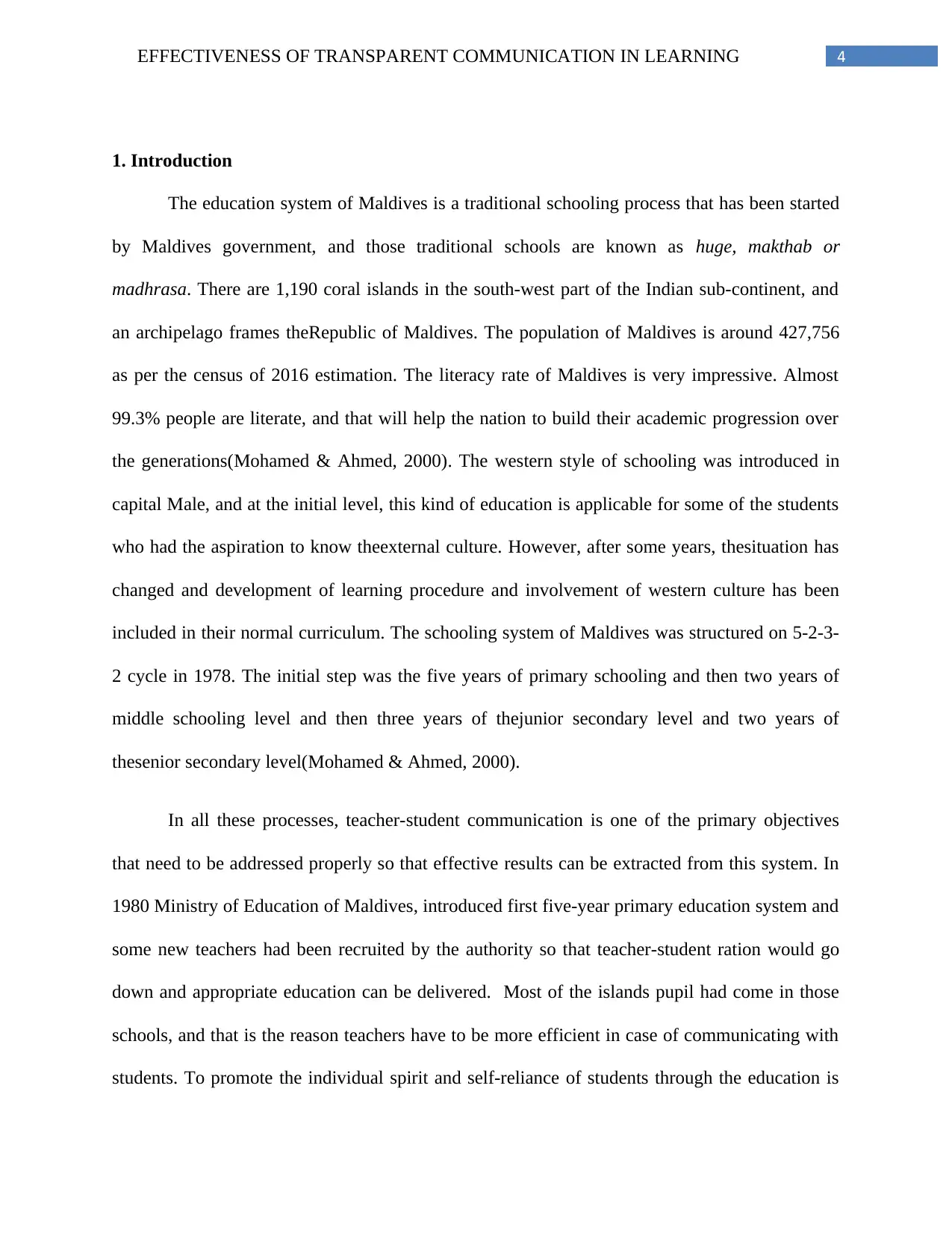
4EFFECTIVENESS OF TRANSPARENT COMMUNICATION IN LEARNING
1. Introduction
The education system of Maldives is a traditional schooling process that has been started
by Maldives government, and those traditional schools are known as huge, makthab or
madhrasa. There are 1,190 coral islands in the south-west part of the Indian sub-continent, and
an archipelago frames theRepublic of Maldives. The population of Maldives is around 427,756
as per the census of 2016 estimation. The literacy rate of Maldives is very impressive. Almost
99.3% people are literate, and that will help the nation to build their academic progression over
the generations(Mohamed & Ahmed, 2000). The western style of schooling was introduced in
capital Male, and at the initial level, this kind of education is applicable for some of the students
who had the aspiration to know theexternal culture. However, after some years, thesituation has
changed and development of learning procedure and involvement of western culture has been
included in their normal curriculum. The schooling system of Maldives was structured on 5-2-3-
2 cycle in 1978. The initial step was the five years of primary schooling and then two years of
middle schooling level and then three years of thejunior secondary level and two years of
thesenior secondary level(Mohamed & Ahmed, 2000).
In all these processes, teacher-student communication is one of the primary objectives
that need to be addressed properly so that effective results can be extracted from this system. In
1980 Ministry of Education of Maldives, introduced first five-year primary education system and
some new teachers had been recruited by the authority so that teacher-student ration would go
down and appropriate education can be delivered. Most of the islands pupil had come in those
schools, and that is the reason teachers have to be more efficient in case of communicating with
students. To promote the individual spirit and self-reliance of students through the education is
1. Introduction
The education system of Maldives is a traditional schooling process that has been started
by Maldives government, and those traditional schools are known as huge, makthab or
madhrasa. There are 1,190 coral islands in the south-west part of the Indian sub-continent, and
an archipelago frames theRepublic of Maldives. The population of Maldives is around 427,756
as per the census of 2016 estimation. The literacy rate of Maldives is very impressive. Almost
99.3% people are literate, and that will help the nation to build their academic progression over
the generations(Mohamed & Ahmed, 2000). The western style of schooling was introduced in
capital Male, and at the initial level, this kind of education is applicable for some of the students
who had the aspiration to know theexternal culture. However, after some years, thesituation has
changed and development of learning procedure and involvement of western culture has been
included in their normal curriculum. The schooling system of Maldives was structured on 5-2-3-
2 cycle in 1978. The initial step was the five years of primary schooling and then two years of
middle schooling level and then three years of thejunior secondary level and two years of
thesenior secondary level(Mohamed & Ahmed, 2000).
In all these processes, teacher-student communication is one of the primary objectives
that need to be addressed properly so that effective results can be extracted from this system. In
1980 Ministry of Education of Maldives, introduced first five-year primary education system and
some new teachers had been recruited by the authority so that teacher-student ration would go
down and appropriate education can be delivered. Most of the islands pupil had come in those
schools, and that is the reason teachers have to be more efficient in case of communicating with
students. To promote the individual spirit and self-reliance of students through the education is
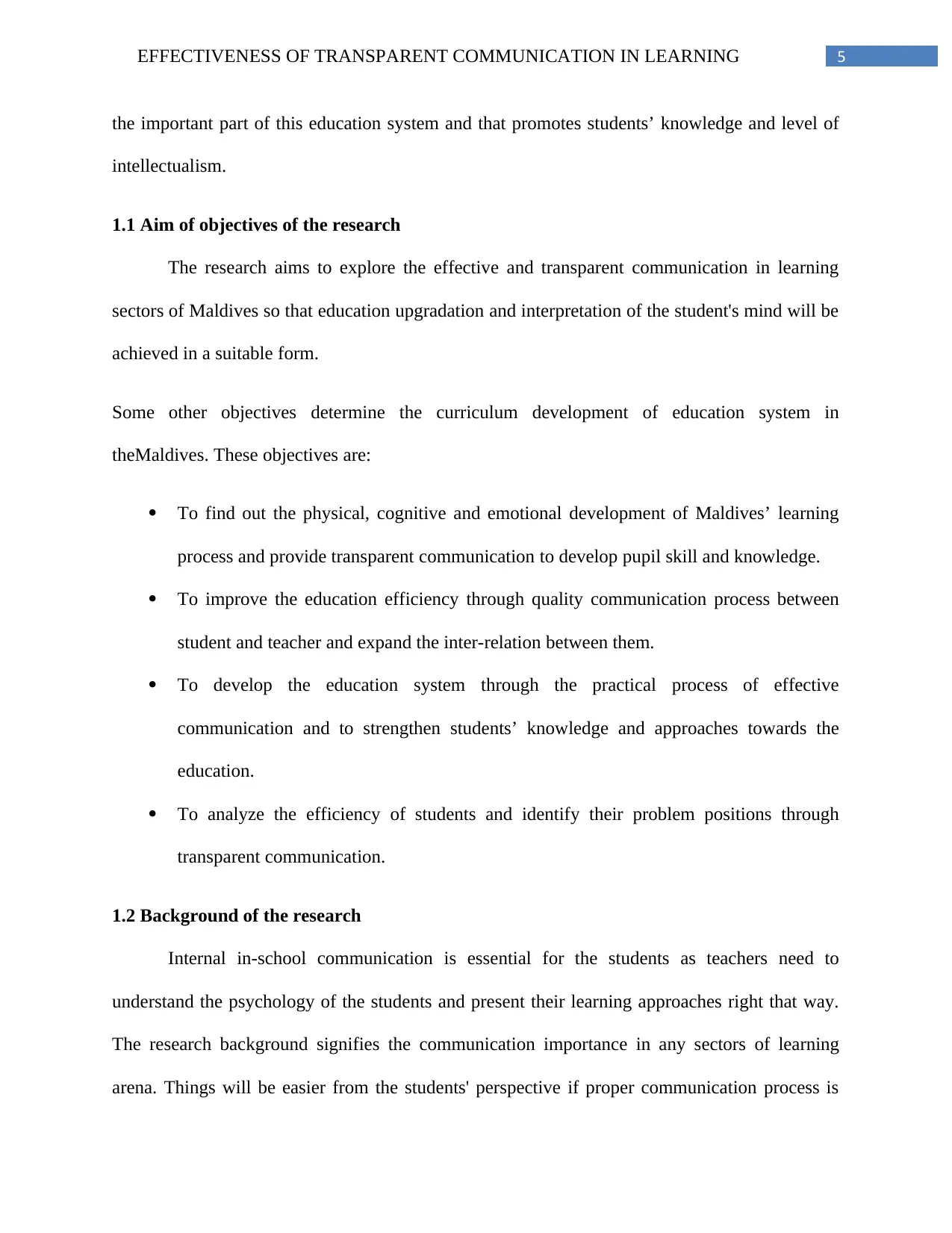
5EFFECTIVENESS OF TRANSPARENT COMMUNICATION IN LEARNING
the important part of this education system and that promotes students’ knowledge and level of
intellectualism.
1.1 Aim of objectives of the research
The research aims to explore the effective and transparent communication in learning
sectors of Maldives so that education upgradation and interpretation of the student's mind will be
achieved in a suitable form.
Some other objectives determine the curriculum development of education system in
theMaldives. These objectives are:
To find out the physical, cognitive and emotional development of Maldives’ learning
process and provide transparent communication to develop pupil skill and knowledge.
To improve the education efficiency through quality communication process between
student and teacher and expand the inter-relation between them.
To develop the education system through the practical process of effective
communication and to strengthen students’ knowledge and approaches towards the
education.
To analyze the efficiency of students and identify their problem positions through
transparent communication.
1.2 Background of the research
Internal in-school communication is essential for the students as teachers need to
understand the psychology of the students and present their learning approaches right that way.
The research background signifies the communication importance in any sectors of learning
arena. Things will be easier from the students' perspective if proper communication process is
the important part of this education system and that promotes students’ knowledge and level of
intellectualism.
1.1 Aim of objectives of the research
The research aims to explore the effective and transparent communication in learning
sectors of Maldives so that education upgradation and interpretation of the student's mind will be
achieved in a suitable form.
Some other objectives determine the curriculum development of education system in
theMaldives. These objectives are:
To find out the physical, cognitive and emotional development of Maldives’ learning
process and provide transparent communication to develop pupil skill and knowledge.
To improve the education efficiency through quality communication process between
student and teacher and expand the inter-relation between them.
To develop the education system through the practical process of effective
communication and to strengthen students’ knowledge and approaches towards the
education.
To analyze the efficiency of students and identify their problem positions through
transparent communication.
1.2 Background of the research
Internal in-school communication is essential for the students as teachers need to
understand the psychology of the students and present their learning approaches right that way.
The research background signifies the communication importance in any sectors of learning
arena. Things will be easier from the students' perspective if proper communication process is
⊘ This is a preview!⊘
Do you want full access?
Subscribe today to unlock all pages.

Trusted by 1+ million students worldwide
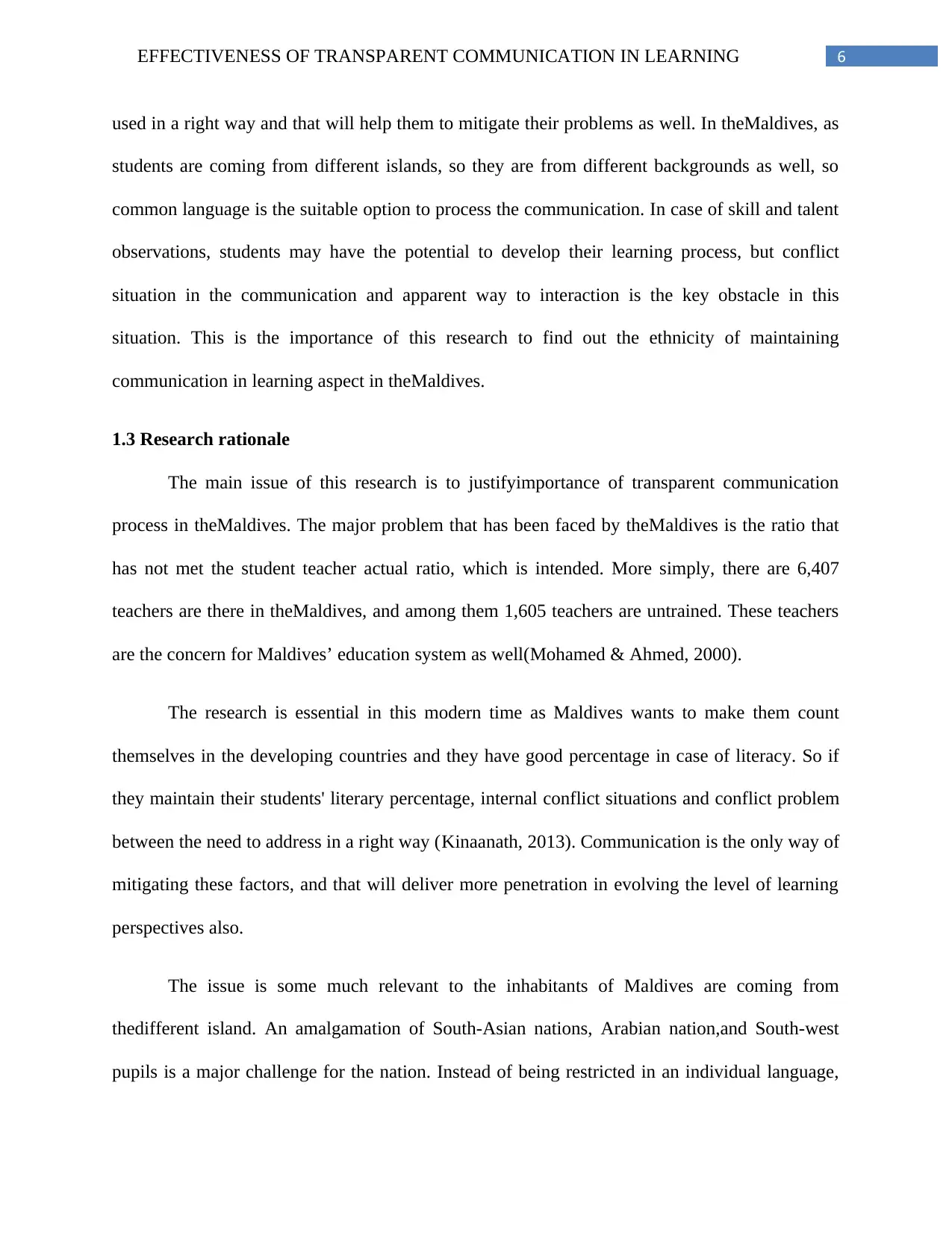
6EFFECTIVENESS OF TRANSPARENT COMMUNICATION IN LEARNING
used in a right way and that will help them to mitigate their problems as well. In theMaldives, as
students are coming from different islands, so they are from different backgrounds as well, so
common language is the suitable option to process the communication. In case of skill and talent
observations, students may have the potential to develop their learning process, but conflict
situation in the communication and apparent way to interaction is the key obstacle in this
situation. This is the importance of this research to find out the ethnicity of maintaining
communication in learning aspect in theMaldives.
1.3 Research rationale
The main issue of this research is to justifyimportance of transparent communication
process in theMaldives. The major problem that has been faced by theMaldives is the ratio that
has not met the student teacher actual ratio, which is intended. More simply, there are 6,407
teachers are there in theMaldives, and among them 1,605 teachers are untrained. These teachers
are the concern for Maldives’ education system as well(Mohamed & Ahmed, 2000).
The research is essential in this modern time as Maldives wants to make them count
themselves in the developing countries and they have good percentage in case of literacy. So if
they maintain their students' literary percentage, internal conflict situations and conflict problem
between the need to address in a right way (Kinaanath, 2013). Communication is the only way of
mitigating these factors, and that will deliver more penetration in evolving the level of learning
perspectives also.
The issue is some much relevant to the inhabitants of Maldives are coming from
thedifferent island. An amalgamation of South-Asian nations, Arabian nation,and South-west
pupils is a major challenge for the nation. Instead of being restricted in an individual language,
used in a right way and that will help them to mitigate their problems as well. In theMaldives, as
students are coming from different islands, so they are from different backgrounds as well, so
common language is the suitable option to process the communication. In case of skill and talent
observations, students may have the potential to develop their learning process, but conflict
situation in the communication and apparent way to interaction is the key obstacle in this
situation. This is the importance of this research to find out the ethnicity of maintaining
communication in learning aspect in theMaldives.
1.3 Research rationale
The main issue of this research is to justifyimportance of transparent communication
process in theMaldives. The major problem that has been faced by theMaldives is the ratio that
has not met the student teacher actual ratio, which is intended. More simply, there are 6,407
teachers are there in theMaldives, and among them 1,605 teachers are untrained. These teachers
are the concern for Maldives’ education system as well(Mohamed & Ahmed, 2000).
The research is essential in this modern time as Maldives wants to make them count
themselves in the developing countries and they have good percentage in case of literacy. So if
they maintain their students' literary percentage, internal conflict situations and conflict problem
between the need to address in a right way (Kinaanath, 2013). Communication is the only way of
mitigating these factors, and that will deliver more penetration in evolving the level of learning
perspectives also.
The issue is some much relevant to the inhabitants of Maldives are coming from
thedifferent island. An amalgamation of South-Asian nations, Arabian nation,and South-west
pupils is a major challenge for the nation. Instead of being restricted in an individual language,
Paraphrase This Document
Need a fresh take? Get an instant paraphrase of this document with our AI Paraphraser
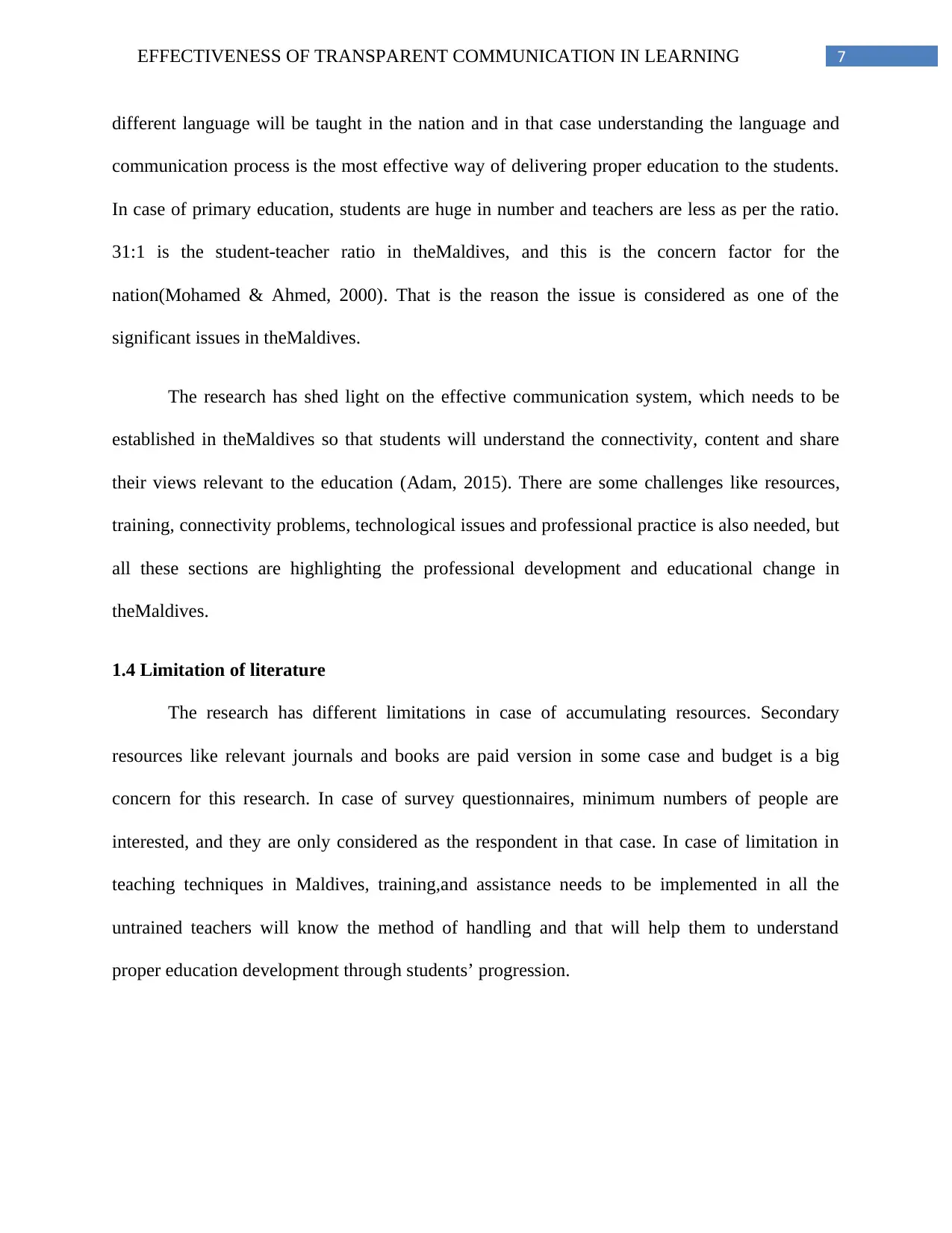
7EFFECTIVENESS OF TRANSPARENT COMMUNICATION IN LEARNING
different language will be taught in the nation and in that case understanding the language and
communication process is the most effective way of delivering proper education to the students.
In case of primary education, students are huge in number and teachers are less as per the ratio.
31:1 is the student-teacher ratio in theMaldives, and this is the concern factor for the
nation(Mohamed & Ahmed, 2000). That is the reason the issue is considered as one of the
significant issues in theMaldives.
The research has shed light on the effective communication system, which needs to be
established in theMaldives so that students will understand the connectivity, content and share
their views relevant to the education (Adam, 2015). There are some challenges like resources,
training, connectivity problems, technological issues and professional practice is also needed, but
all these sections are highlighting the professional development and educational change in
theMaldives.
1.4 Limitation of literature
The research has different limitations in case of accumulating resources. Secondary
resources like relevant journals and books are paid version in some case and budget is a big
concern for this research. In case of survey questionnaires, minimum numbers of people are
interested, and they are only considered as the respondent in that case. In case of limitation in
teaching techniques in Maldives, training,and assistance needs to be implemented in all the
untrained teachers will know the method of handling and that will help them to understand
proper education development through students’ progression.
different language will be taught in the nation and in that case understanding the language and
communication process is the most effective way of delivering proper education to the students.
In case of primary education, students are huge in number and teachers are less as per the ratio.
31:1 is the student-teacher ratio in theMaldives, and this is the concern factor for the
nation(Mohamed & Ahmed, 2000). That is the reason the issue is considered as one of the
significant issues in theMaldives.
The research has shed light on the effective communication system, which needs to be
established in theMaldives so that students will understand the connectivity, content and share
their views relevant to the education (Adam, 2015). There are some challenges like resources,
training, connectivity problems, technological issues and professional practice is also needed, but
all these sections are highlighting the professional development and educational change in
theMaldives.
1.4 Limitation of literature
The research has different limitations in case of accumulating resources. Secondary
resources like relevant journals and books are paid version in some case and budget is a big
concern for this research. In case of survey questionnaires, minimum numbers of people are
interested, and they are only considered as the respondent in that case. In case of limitation in
teaching techniques in Maldives, training,and assistance needs to be implemented in all the
untrained teachers will know the method of handling and that will help them to understand
proper education development through students’ progression.
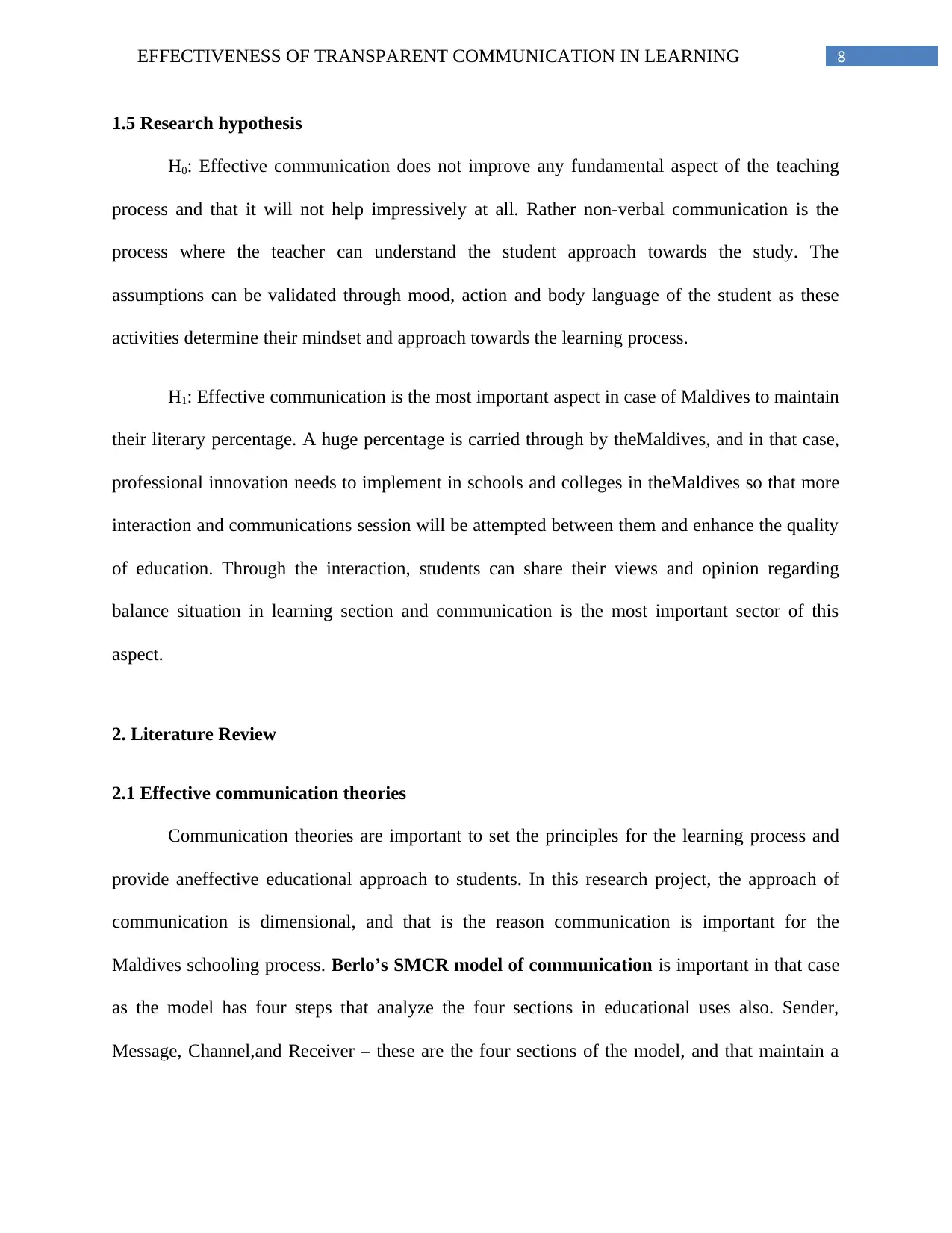
8EFFECTIVENESS OF TRANSPARENT COMMUNICATION IN LEARNING
1.5 Research hypothesis
H0: Effective communication does not improve any fundamental aspect of the teaching
process and that it will not help impressively at all. Rather non-verbal communication is the
process where the teacher can understand the student approach towards the study. The
assumptions can be validated through mood, action and body language of the student as these
activities determine their mindset and approach towards the learning process.
H1: Effective communication is the most important aspect in case of Maldives to maintain
their literary percentage. A huge percentage is carried through by theMaldives, and in that case,
professional innovation needs to implement in schools and colleges in theMaldives so that more
interaction and communications session will be attempted between them and enhance the quality
of education. Through the interaction, students can share their views and opinion regarding
balance situation in learning section and communication is the most important sector of this
aspect.
2. Literature Review
2.1 Effective communication theories
Communication theories are important to set the principles for the learning process and
provide aneffective educational approach to students. In this research project, the approach of
communication is dimensional, and that is the reason communication is important for the
Maldives schooling process. Berlo’s SMCR model of communication is important in that case
as the model has four steps that analyze the four sections in educational uses also. Sender,
Message, Channel,and Receiver – these are the four sections of the model, and that maintain a
1.5 Research hypothesis
H0: Effective communication does not improve any fundamental aspect of the teaching
process and that it will not help impressively at all. Rather non-verbal communication is the
process where the teacher can understand the student approach towards the study. The
assumptions can be validated through mood, action and body language of the student as these
activities determine their mindset and approach towards the learning process.
H1: Effective communication is the most important aspect in case of Maldives to maintain
their literary percentage. A huge percentage is carried through by theMaldives, and in that case,
professional innovation needs to implement in schools and colleges in theMaldives so that more
interaction and communications session will be attempted between them and enhance the quality
of education. Through the interaction, students can share their views and opinion regarding
balance situation in learning section and communication is the most important sector of this
aspect.
2. Literature Review
2.1 Effective communication theories
Communication theories are important to set the principles for the learning process and
provide aneffective educational approach to students. In this research project, the approach of
communication is dimensional, and that is the reason communication is important for the
Maldives schooling process. Berlo’s SMCR model of communication is important in that case
as the model has four steps that analyze the four sections in educational uses also. Sender,
Message, Channel,and Receiver – these are the four sections of the model, and that maintain a
⊘ This is a preview!⊘
Do you want full access?
Subscribe today to unlock all pages.

Trusted by 1+ million students worldwide
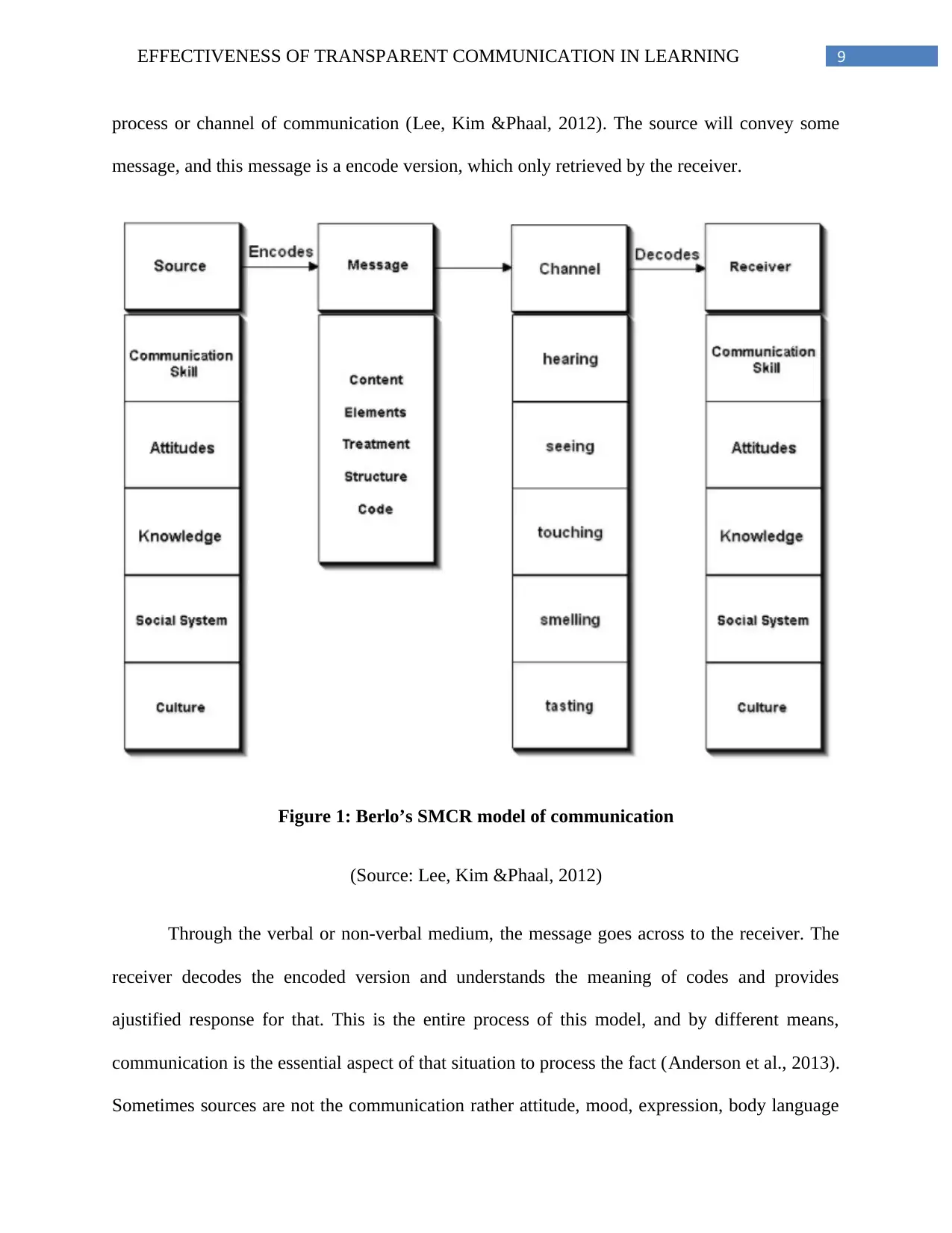
9EFFECTIVENESS OF TRANSPARENT COMMUNICATION IN LEARNING
process or channel of communication (Lee, Kim &Phaal, 2012). The source will convey some
message, and this message is a encode version, which only retrieved by the receiver.
Figure 1: Berlo’s SMCR model of communication
(Source: Lee, Kim &Phaal, 2012)
Through the verbal or non-verbal medium, the message goes across to the receiver. The
receiver decodes the encoded version and understands the meaning of codes and provides
ajustified response for that. This is the entire process of this model, and by different means,
communication is the essential aspect of that situation to process the fact (Anderson et al., 2013).
Sometimes sources are not the communication rather attitude, mood, expression, body language
process or channel of communication (Lee, Kim &Phaal, 2012). The source will convey some
message, and this message is a encode version, which only retrieved by the receiver.
Figure 1: Berlo’s SMCR model of communication
(Source: Lee, Kim &Phaal, 2012)
Through the verbal or non-verbal medium, the message goes across to the receiver. The
receiver decodes the encoded version and understands the meaning of codes and provides
ajustified response for that. This is the entire process of this model, and by different means,
communication is the essential aspect of that situation to process the fact (Anderson et al., 2013).
Sometimes sources are not the communication rather attitude, mood, expression, body language
Paraphrase This Document
Need a fresh take? Get an instant paraphrase of this document with our AI Paraphraser
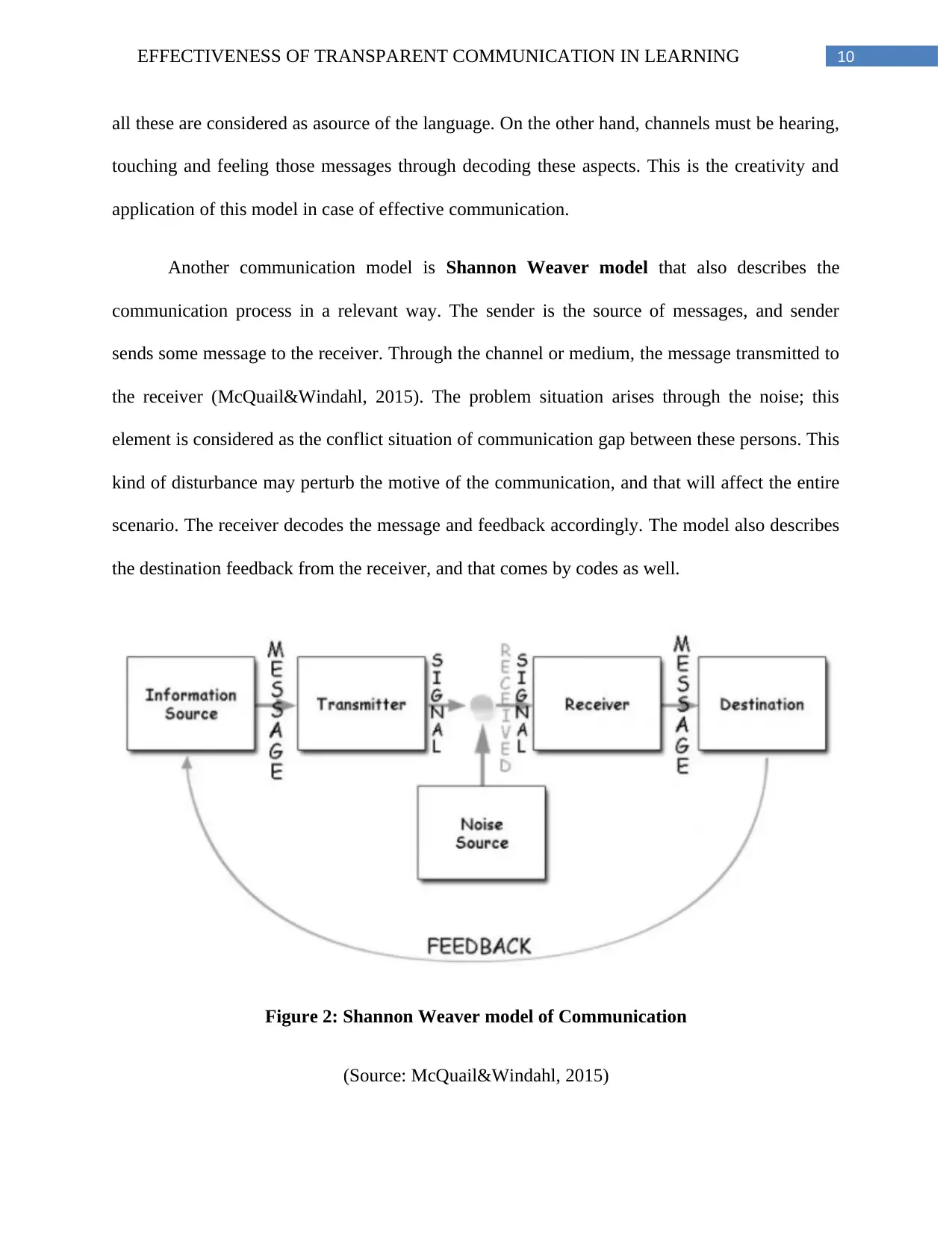
10EFFECTIVENESS OF TRANSPARENT COMMUNICATION IN LEARNING
all these are considered as asource of the language. On the other hand, channels must be hearing,
touching and feeling those messages through decoding these aspects. This is the creativity and
application of this model in case of effective communication.
Another communication model is Shannon Weaver model that also describes the
communication process in a relevant way. The sender is the source of messages, and sender
sends some message to the receiver. Through the channel or medium, the message transmitted to
the receiver (McQuail&Windahl, 2015). The problem situation arises through the noise; this
element is considered as the conflict situation of communication gap between these persons. This
kind of disturbance may perturb the motive of the communication, and that will affect the entire
scenario. The receiver decodes the message and feedback accordingly. The model also describes
the destination feedback from the receiver, and that comes by codes as well.
Figure 2: Shannon Weaver model of Communication
(Source: McQuail&Windahl, 2015)
all these are considered as asource of the language. On the other hand, channels must be hearing,
touching and feeling those messages through decoding these aspects. This is the creativity and
application of this model in case of effective communication.
Another communication model is Shannon Weaver model that also describes the
communication process in a relevant way. The sender is the source of messages, and sender
sends some message to the receiver. Through the channel or medium, the message transmitted to
the receiver (McQuail&Windahl, 2015). The problem situation arises through the noise; this
element is considered as the conflict situation of communication gap between these persons. This
kind of disturbance may perturb the motive of the communication, and that will affect the entire
scenario. The receiver decodes the message and feedback accordingly. The model also describes
the destination feedback from the receiver, and that comes by codes as well.
Figure 2: Shannon Weaver model of Communication
(Source: McQuail&Windahl, 2015)
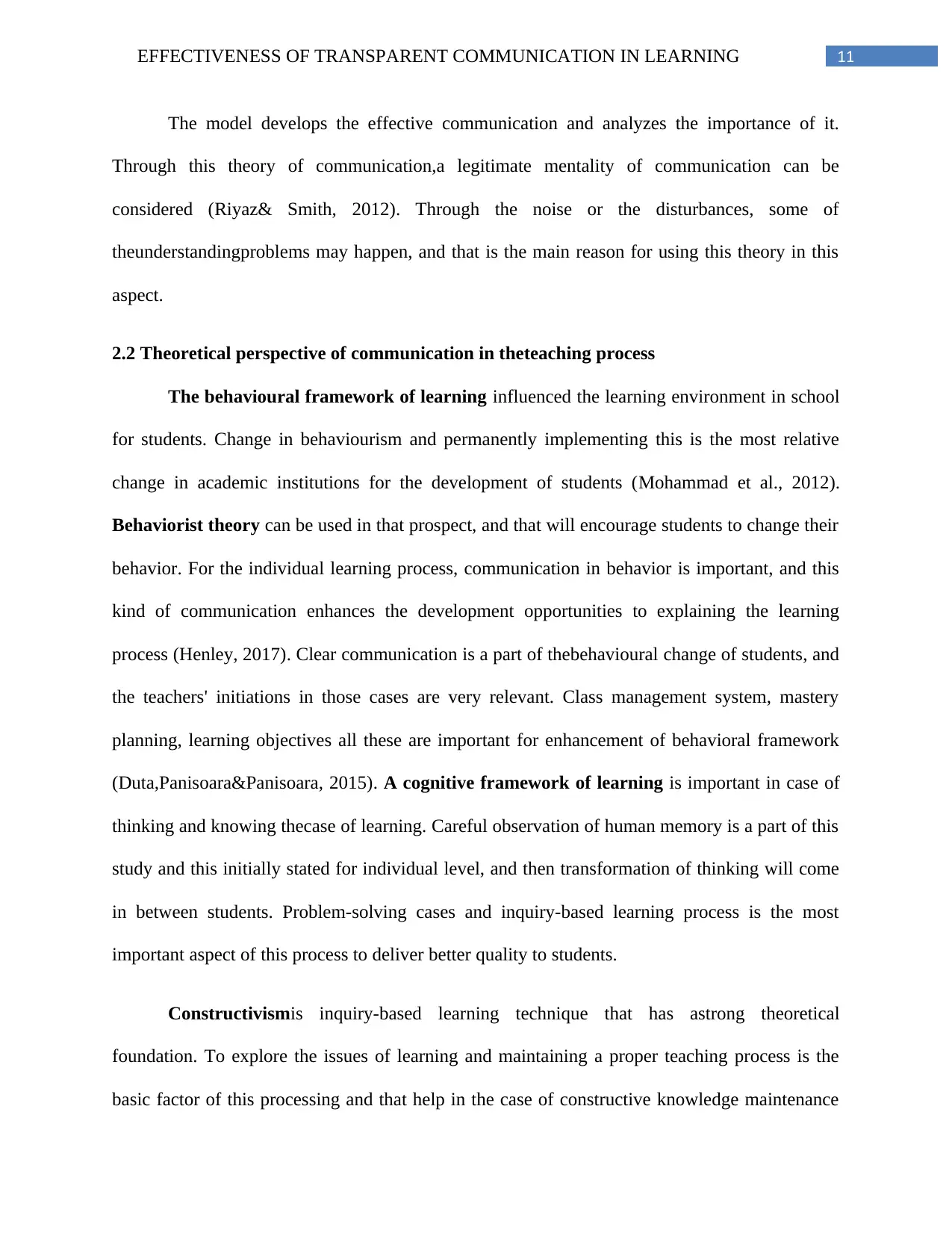
11EFFECTIVENESS OF TRANSPARENT COMMUNICATION IN LEARNING
The model develops the effective communication and analyzes the importance of it.
Through this theory of communication,a legitimate mentality of communication can be
considered (Riyaz& Smith, 2012). Through the noise or the disturbances, some of
theunderstandingproblems may happen, and that is the main reason for using this theory in this
aspect.
2.2 Theoretical perspective of communication in theteaching process
The behavioural framework of learning influenced the learning environment in school
for students. Change in behaviourism and permanently implementing this is the most relative
change in academic institutions for the development of students (Mohammad et al., 2012).
Behaviorist theory can be used in that prospect, and that will encourage students to change their
behavior. For the individual learning process, communication in behavior is important, and this
kind of communication enhances the development opportunities to explaining the learning
process (Henley, 2017). Clear communication is a part of thebehavioural change of students, and
the teachers' initiations in those cases are very relevant. Class management system, mastery
planning, learning objectives all these are important for enhancement of behavioral framework
(Duta,Panisoara&Panisoara, 2015). A cognitive framework of learning is important in case of
thinking and knowing thecase of learning. Careful observation of human memory is a part of this
study and this initially stated for individual level, and then transformation of thinking will come
in between students. Problem-solving cases and inquiry-based learning process is the most
important aspect of this process to deliver better quality to students.
Constructivismis inquiry-based learning technique that has astrong theoretical
foundation. To explore the issues of learning and maintaining a proper teaching process is the
basic factor of this processing and that help in the case of constructive knowledge maintenance
The model develops the effective communication and analyzes the importance of it.
Through this theory of communication,a legitimate mentality of communication can be
considered (Riyaz& Smith, 2012). Through the noise or the disturbances, some of
theunderstandingproblems may happen, and that is the main reason for using this theory in this
aspect.
2.2 Theoretical perspective of communication in theteaching process
The behavioural framework of learning influenced the learning environment in school
for students. Change in behaviourism and permanently implementing this is the most relative
change in academic institutions for the development of students (Mohammad et al., 2012).
Behaviorist theory can be used in that prospect, and that will encourage students to change their
behavior. For the individual learning process, communication in behavior is important, and this
kind of communication enhances the development opportunities to explaining the learning
process (Henley, 2017). Clear communication is a part of thebehavioural change of students, and
the teachers' initiations in those cases are very relevant. Class management system, mastery
planning, learning objectives all these are important for enhancement of behavioral framework
(Duta,Panisoara&Panisoara, 2015). A cognitive framework of learning is important in case of
thinking and knowing thecase of learning. Careful observation of human memory is a part of this
study and this initially stated for individual level, and then transformation of thinking will come
in between students. Problem-solving cases and inquiry-based learning process is the most
important aspect of this process to deliver better quality to students.
Constructivismis inquiry-based learning technique that has astrong theoretical
foundation. To explore the issues of learning and maintaining a proper teaching process is the
basic factor of this processing and that help in the case of constructive knowledge maintenance
⊘ This is a preview!⊘
Do you want full access?
Subscribe today to unlock all pages.

Trusted by 1+ million students worldwide
1 out of 33
Related Documents
Your All-in-One AI-Powered Toolkit for Academic Success.
+13062052269
info@desklib.com
Available 24*7 on WhatsApp / Email
![[object Object]](/_next/static/media/star-bottom.7253800d.svg)
Unlock your academic potential
Copyright © 2020–2025 A2Z Services. All Rights Reserved. Developed and managed by ZUCOL.





